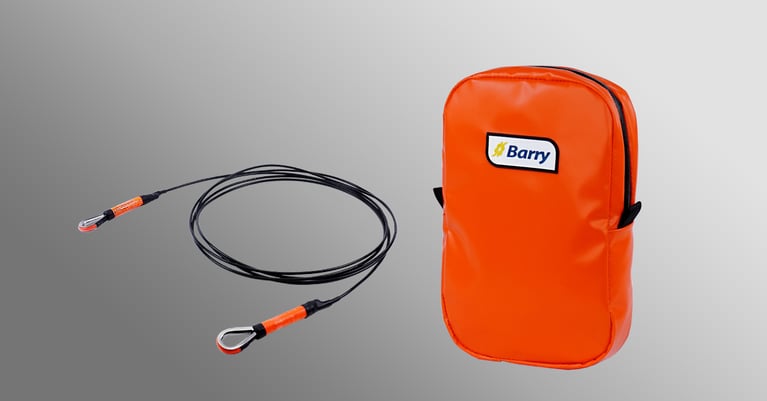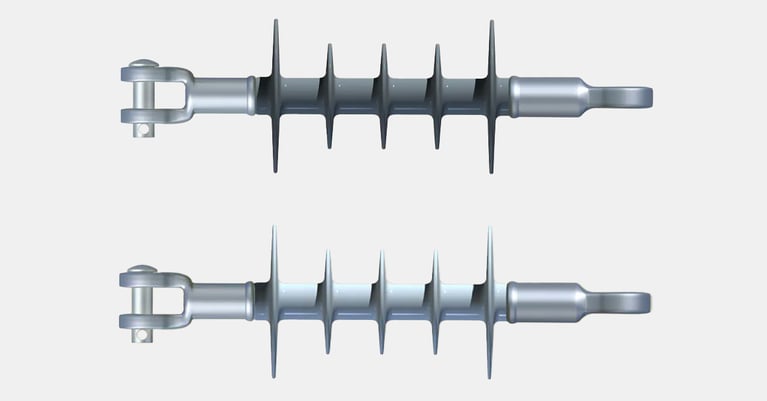Brief History of Materials Used in High Voltage Insulator Construction
As the power grid continued its expansion in the latter part of the 19th century, it became even more critical to safely and effectively insulate the high voltage lines from its surroundings. Telegraph lines had been supported primarily by glass insulators for decades, but these same glass insulators weren’t sufficient for high voltage power lines. Similar in its ceramic nature, but more durable in its construction, porcelain became the primary material for high voltage insulator construction.
Porcelain Insulators

Voltages increased over time and applications became more diverse supported by the moldability of porcelain to create new designs. Porcelain material was readily available and the manufacturing process is fairly straight forward and consistently repeatable. Combined with effective electrical characteristics, porcelain served as a versatile, yet durable product that could support the mechanical requirements while withstanding the electrical stresses of the high voltage requirements for decades of service life. Porcelain, like other ceramic materials, has high compressive strength. This compressive strength lends well to the use of porcelain in compressive load applications such as line post insulators and station post insulators. However, the ingenuity of the design of the cap and pin porcelain suspension insulator utilized the compressive strength of porcelain to create a tension-bearing suspension insulator in 1909 and this same design is still used today.
Toughened Glass Bell Insulators
The modular design of the porcelain bell further simplified manufacturing and the versatility of adjusting the number of bells allowed for the adaptation of the string length for various voltages. This same porcelain bell design led to the re-introduction of glass for high voltage applications as a toughened glass bell became an alternative to porcelain bells.
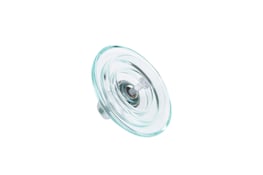
These glass bells used a tempering process to toughen the glass and thus with its clarity and stress-induced strengthening process, glass material provided improvements in inspection practices both for imperfections during manufacture as well as the field due to the complete destruction of the bell should sufficient damage occur. While this could be seen as a negative, this completely destroyed failure-mode effectively indicates the failed bell unlike the porcelain suspension bells that can appear intact even though a failure of the porcelain bell has occurred. This makes glass bell failures easier to find, and while the ruptured glass retains sufficient strength to hold the line, inspection crews can more easily locate the failure and then schedule an appropriate time for replacement.
Polymer Insulators
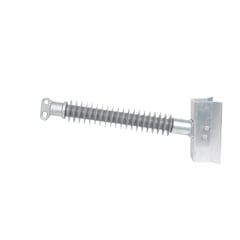 However, the use of porcelain and glass material continued to have challenges to meet the needs of the growing power grid. The desire was to overcome challenges such as the increased weight of porcelain and glass or to provide improved performance in contaminated environments. This created an opportunity for the exploration of products classified as non-ceramic insulators (NCIs). While various designs have been introduced over the decades, the most widely used designs today consist of metal end fittings crimped to a fiberglass rod with a polymer housing to protect the rod. This design offers multiple advantages such as weight savings, improved contamination and flashover performance, and increased design versatility. These designs of non-ceramic insulators were first introduced in the 1960’s but they now lead as the largest segment of the industry compared to glass or porcelain.
However, the use of porcelain and glass material continued to have challenges to meet the needs of the growing power grid. The desire was to overcome challenges such as the increased weight of porcelain and glass or to provide improved performance in contaminated environments. This created an opportunity for the exploration of products classified as non-ceramic insulators (NCIs). While various designs have been introduced over the decades, the most widely used designs today consist of metal end fittings crimped to a fiberglass rod with a polymer housing to protect the rod. This design offers multiple advantages such as weight savings, improved contamination and flashover performance, and increased design versatility. These designs of non-ceramic insulators were first introduced in the 1960’s but they now lead as the largest segment of the industry compared to glass or porcelain.
Insulator Materials Today
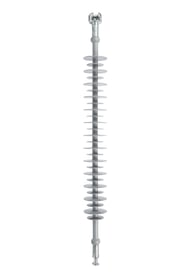 Polymer insulators have displaced porcelain as the insulator of preference for many insulator applications across North America in some of the most challenging and highest voltage applications. One such application is the combination of a line post supported with a suspension insulator called a braced line post. This design offers increased mechanical strength versus a traditional line post but allows for advantages in tower design and right of way reduction. Utility designs today have even evolved to using polymer braced line posts up to 500kV because of the tremendous advantages.
Polymer insulators have displaced porcelain as the insulator of preference for many insulator applications across North America in some of the most challenging and highest voltage applications. One such application is the combination of a line post supported with a suspension insulator called a braced line post. This design offers increased mechanical strength versus a traditional line post but allows for advantages in tower design and right of way reduction. Utility designs today have even evolved to using polymer braced line posts up to 500kV because of the tremendous advantages.
The insulator market is generally separated by materials in various classes: porcelain material remains a preference for station post applications, glass has increased significantly as the widely accepted and even preferred option for transmission suspension strings, and polymer insulators fill an array of applications across a broad voltage range from distribution to transmission voltages for suspension, line post and braced line post applications.
Hubbell and High Voltage Insulators
Hubbell has played an important role in high voltage insulators for over 130 years. Hubbell was founded in 1888, the same year as Ohio Brass which joined the Hubbell family in 1978. Ohio Brass played a key role in the early development of high voltage porcelain suspension insulators such as holding the original patent for the common cap and pin design used today. Ohio Brass porcelain bell insulators were also used on the first high voltage transmission line in North America, the 110kV line at Niagara Falls generation station. Ohio Brass continued as a leader in the porcelain insulator industry for many decades.
Following 12 years of research and development into polymer insulator technology, Hubbell introduced their first polymer insulators in 1976 through the Ohio Brass brand. The success of the Hubbell polymer insulator and the growth of that market segment fueled the eventual exit of Ohio Brass from further porcelain manufacturing in 1986. Today, Hubbell continues to manufacture polymer insulators in their facility in Aiken, SC as well as supported with Hubbell facilities in Mexico, China, and Brazil.
Hubbell offers one of the broadest insulator product offerings across distribution, substation, and transmission insulator products. Distribution products are offered for both polymer suspension and line post insulators using housings of either Hubbell’s unique and proprietary ESP™ polymer or Hubbell’s proprietary silicone rubber. Station post insulators are offered in the solid porcelain post design as well as the light-weight and hydrophobic polymer design using Hubbell proprietary silicone rubber. The transmission insulator offering includes polymer insulators in either suspension or line post design offered in either Hubbell’s unique and proprietary ESP™ polymer or Hubbell proprietary silicone rubber. Hubbell also offers an extensive line of glass bell suspension insulators supported by our partnership with Verescence La Granja Insulators manufactured in Spain. Hubbell’s extensive insulator offering provides multiple design and material options to meet the important insulator needs of high voltage projects and utility customers around the world.

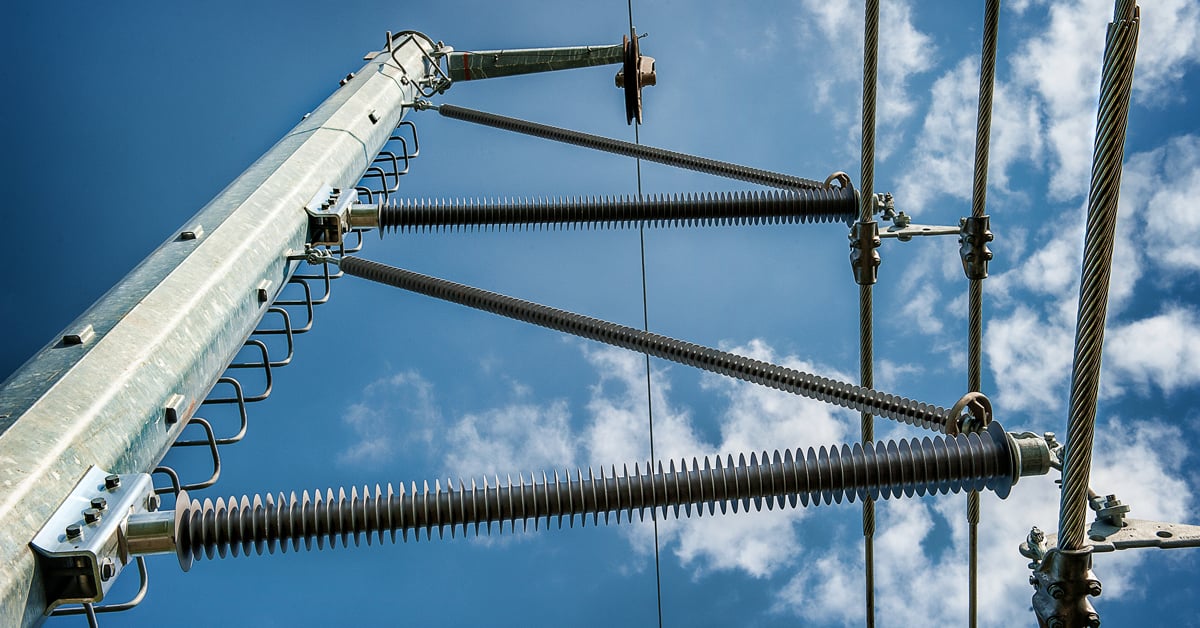


 However, the use of porcelain and glass material continued to have challenges to meet the needs of the growing power grid. The desire was to overcome challenges such as the increased weight of porcelain and glass or to provide improved performance in contaminated environments. This created an opportunity for the exploration of products classified as non-ceramic insulators (NCIs). While various designs have been introduced over the decades, the most widely used designs today consist of metal end fittings crimped to a fiberglass rod with a polymer housing to protect the rod. This design offers multiple advantages such as weight savings, improved contamination and flashover performance, and increased design versatility.
However, the use of porcelain and glass material continued to have challenges to meet the needs of the growing power grid. The desire was to overcome challenges such as the increased weight of porcelain and glass or to provide improved performance in contaminated environments. This created an opportunity for the exploration of products classified as non-ceramic insulators (NCIs). While various designs have been introduced over the decades, the most widely used designs today consist of metal end fittings crimped to a fiberglass rod with a polymer housing to protect the rod. This design offers multiple advantages such as weight savings, improved contamination and flashover performance, and increased design versatility.  Polymer insulators have displaced porcelain as the insulator of preference for many insulator applications across North America in some of the most challenging and highest voltage applications. One such application is the combination of a line post supported with a suspension insulator called a braced line post. This design offers increased mechanical strength versus a traditional line post but allows for advantages in tower design and right of way reduction. Utility designs today have even evolved to using polymer braced line posts up to 500kV because of the tremendous advantages.
Polymer insulators have displaced porcelain as the insulator of preference for many insulator applications across North America in some of the most challenging and highest voltage applications. One such application is the combination of a line post supported with a suspension insulator called a braced line post. This design offers increased mechanical strength versus a traditional line post but allows for advantages in tower design and right of way reduction. Utility designs today have even evolved to using polymer braced line posts up to 500kV because of the tremendous advantages.

